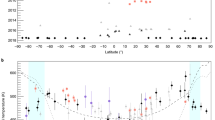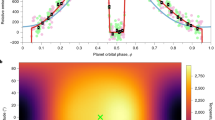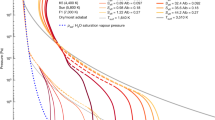Abstract
The upper atmospheres of the four Solar System giant planets exhibit high temperatures1,2 that cannot be explained by the absorption of sunlight2,3. In the case of Saturn the temperatures predicted by models of solar heating2,4 are ∼200 K, compared to temperatures of ∼400 K observed independently in the polar regions5 and at 30° latitude6. This unexplained ‘energy crisis’ represents a major gap in our understanding of these planets’ atmospheres. An important candidate for the source of the missing energy is the magnetosphere1,2,4,7,8,9, which injects energy mostly in the polar regions of the planet. This polar energy input is believed to be sufficient to explain the observed temperatures9, provided that it is efficiently redistributed globally by winds4,8, a process that is not well understood. Here we show, using a numerical model4, that the net effect of the winds driven by the polar energy inputs is not to heat but to cool the low-latitude thermosphere. This surprising result allows us to rule out known polar energy inputs as the solution to the energy crisis at Saturn. There is either an unknown—and large—source of polar energy, or, more probably, some other process heats low latitudes directly.
This is a preview of subscription content, access via your institution
Access options
Subscribe to this journal
Receive 51 print issues and online access
$199.00 per year
only $3.90 per issue
Buy this article
- Purchase on Springer Link
- Instant access to full article PDF
Prices may be subject to local taxes which are calculated during checkout


Similar content being viewed by others
References
Atreya, S. K. Atmosphere and Ionospheres of the Outer Planets and their Satellites Ch. 2 (Springer, Heidelberg, 1986)
Yelle, R. V. & Miller, S. in Jupiter: Planet, Satellites and Magnetosphere (eds Bagenal, F., McKinnon, W. & Dowling, T.) 185–218 (Cambridge Univ. Press, Cambridge, UK, 2004)
Strobel, D. F. & Smith, G. R. On the temperature of the jovian thermosphere. J. Atmos. Sci. 30, 718–725 (1973)
Mueller-Wodarg, I. C. F., Mendillo, M., Yelle, R. V. & Aylward, A. D. A global circulation model of Saturn’s thermosphere. Icarus 180, 147–160 (2006)
Melin, H. Comparative Aeronomy of the Upper Atmospheres of the Giant Planets. PhD thesis, Univ. London. (2006)
Smith, G. R. et al. Saturn’s upper atmosphere from the Voyager 2 EUV solar and stellar occultations. J. Geophys. Res. 88, 8667–8679 (1983)
Smith, C. G. A., Miller, S. & Aylward, A. D. Magnetospheric energy inputs into the upper atmospheres of the giant planets. Ann. Geophys. 23, 1943–1947 (2005)
Smith, C. G. A., Aylward, A. D., Miller, S. & Mueller-Wodarg, I. C. F. Polar heating in Saturn’s thermosphere. Ann. Geophys. 23, 2465–2477 (2005)
Cowley, S. W. H., Bunce, E. J. & O’Rourke, J. M. A simple quantitative model of plasma flows and currents in Saturn’s polar ionosphere. J. Geophys. Res. A18, 5212–5230 (2004)
Fuller-Rowell, T. J. et al. in STEP Handbook of Ionospheric Models 217–238 (SCOSTEP, Logan, Utah, 1996)
Moses, J. I. et al. Photochemistry of Saturn’s atmosphere. I. Hydrocarbon chemistry and comparisons with ISO observations. Icarus 143, 244–298 (2000)
Atreya, S. K. Eddy mixing coefficient on Saturn. Planet. Space Sci. 30, 849–854 (1982)
Davis, L. J. & Smith, E. J. A model of Saturn’s magnetic field based on all available data. J. Geophys. Res. 95, 15257–15261 (1990)
Moore, L. E., Mendillo, M., Mueller-Wodarg, I. C. F. & Murr, D. L. Modeling of global variations and ring shadowing in Saturn’s ionosphere. Icarus 172, 503–520 (2004)
Richardson, J. D. Thermal ions and Saturn—Plasma parameters and implications. J. Geophys. Res. 91, 1381–1389 (1986)
Stallard, T. S., Miller, S., Trafton, L. M., Geballe, T. R. & Joseph, R. D. Ion winds in Saturn’s southern auroral/polar region. Icarus 167, 204–211 (2004)
Clarke, J. T. et al. Morphological differences between Saturn’s ultraviolet aurorae and those of Earth and Jupiter. Nature 433, 717–719 (2005)
Codrescu, M. V., Fuller-Rowell, T. J. & Foster, J. C. On the importance of E-field variability for Joule heating in the high-latitude thermosphere. Geophys. Res. Lett. 22, 2393–2396 (1995)
Young, L. A., Yelle, R. V., Young, R., Seiff, A. & Kirk, D. B. Gravity waves in Jupiter’s thermosphere. Science 276, 108–111 (1997)
Matcheva, K. I. & Strobel, D. F. Heating of Jupiter’s thermosphere by dissipation of gravity waves due to molecular viscosity and heat conduction. Icarus 140, 328–340 (1999)
Hickey, M. P., Walterscheid, R. L. & Schubert, G. Gravity wave heating and cooling in Jupiter’s thermosphere. Icarus 148, 266–281 (2000)
Hickey, M. P., Schubert, G. & Walterscheid, R. L. Gravity wave heating and cooling in Saturn’s thermosphere. Eos 86 (Suppl. 18), abstr. SA24A–06. (2005)
Festou, M. C. & Atreya, S. K. Voyager ultraviolet stellar occultation measurements of the composition and thermal profiles of the Saturnian upper atmosphere. Geophys. Res. Lett. 9, 1147–1150 (1982)
Atreya, S. K., Waite, J. H., Donahue, T. M., Nagy, A. F. & McConnell, J. C. in Saturn (eds Gehrels, T. & Matthews, M. S.) 239–277 (Univ. Arizona Press, Tucson, Arizona, 1984)
Smith, G. R. & Hunten, D. M. Study of planetary atmospheres by absorptive occultations. Rev. Geophys. 28, 117–143 (1990)
Acknowledgements
The simulations described in this study were performed using the HiPerSPACE facility at UCL, funded by the UK Particle Physics and Astronomy Research Council (PPARC). C.G.A.S. acknowledges receipt of a CASE studentship funded by PPARC and Sun Microsystems Ltd.
Author Contributions The thermosphere modelling was carried out by C.G.A.S., A.D.A., G.H.M. and S.M. L.E.M. provided the ionosphere model.
Author information
Authors and Affiliations
Corresponding author
Ethics declarations
Competing interests
Reprints and permissions information is available at www.nature.com/reprints. The authors declare no competing financial interests.
Supplementary information
Supplementary Information
This file contains Supplementary Methods, Supplementary Discussion, Supplementary Notes, Supplementary Figures 1-11 with legends and Supplementary Table 1. The file contains further description of the model and discussion of our results, including a detailed description of our numerical thermosphere model, descriptions of our models of ionospheric conductivity and magnetospheric plasma flow, details of our formulation of Joule heating and ion drag, analysis of the detailed force balances calculated by the model, description and discussion of a sensitivity study examining the effect of an increased ionospheric conductivity and a discussion of possible circumstances in which the observed cooling effect may be mitigated, or even reversed. (PDF 1416 kb)
Rights and permissions
About this article
Cite this article
Smith, C., Aylward, A., Millward, G. et al. An unexpected cooling effect in Saturn’s upper atmosphere. Nature 445, 399–401 (2007). https://doi.org/10.1038/nature05518
Received:
Accepted:
Issue Date:
DOI: https://doi.org/10.1038/nature05518
This article is cited by
-
Global upper-atmospheric heating on Jupiter by the polar aurorae
Nature (2021)
-
A pole-to-pole pressure–temperature map of Saturn’s thermosphere from Cassini Grand Finale data
Nature Astronomy (2020)
-
Magnetospheric Studies: A Requirement for Addressing Interdisciplinary Mysteries in the Ice Giant Systems
Space Science Reviews (2020)
-
The creation of electric wind due to the electrohydrodynamic force
Nature Communications (2018)
-
Heating of Jupiter’s upper atmosphere above the Great Red Spot
Nature (2016)
Comments
By submitting a comment you agree to abide by our Terms and Community Guidelines. If you find something abusive or that does not comply with our terms or guidelines please flag it as inappropriate.



